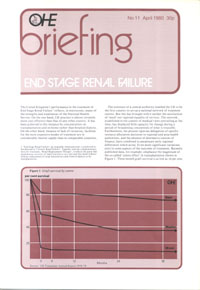Unlocking the Value of Combination Therapies

The United Kingdom’s performance in the treatment of End Stage Renal Failure reflects, in microcosm, many of the strengths and weaknesses of the National Health Service. On the one hand, UK practice is almost certainly more cost-effective than that of any other country.…
The United Kingdom’s performance in the treatment of End Stage Renal Failure reflects, in microcosm, many of the strengths and weaknesses of the National Health Service. On the one hand, UK practice is almost certainly more cost-effective than that of any other country. It has been achieved in this instance by concentration on transplantation and on home rather than hospital dialysis. On the other hand, because of lack of resources, facilities for the most expensive modes of treatment are in considerably shorter supply than in comparable countries. ‘End Stage Renal Failure’, an originally American term, is preferred to the alternative ‘Chronic Renal Failure’. Together with the complementary term for treatment, ‘Renal Replacement Therapy’, it reflects the point that spontaneous recovery of renal function is very rare and that death follows without replacement of renal function by some form of dialysis or by transplantation.
The existence of a central authority enabled the UK to be the first country to set up a national network of treatment centres. But this has brought with it neither the satisfaction of ‘need’ nor regional equality of services. The network, established in the context of medical views prevailing at the time, has displayed little capacity for change during a period of broadening conceptions of what is treatable. Furthermore, the present rigorous delegation of specific resource allocation decisions to regional and area health authorities, and the absence of alternative sources of finance, have combined to perpetuate early regional differences which arose. Even more significant variations exist in some aspects of the outcome of treatment. Recently published data, for example, emphasise the magnitude of the so-called ‘centre effect’ in transplantation shown in Figure 1. Three month graft survival is as low as 14 per cent in some centres and as high as 84 per cent in others.
In public discussion of the issues surrounding End Stage Renal Failure reference is often made to the disparity between its incidence and the rate of intake of new patients. This disparity is higher in Britain than in any other major developed western country. New data from the European Dialysis and Transplant Association (EDTA) makes it clear that Britain’s low overall rate of intake is a consequence of exclusion of older new patients from, or failure to refer them to, renal units. This Briefing discusses aspects of renal service provision in the UK, drawing particular attention to the mechanisms by which access to such care is controlled.
Laing, W.
(1980) End Stage Renal Failure. OHE Briefing. Available from https://www.ohe.org/publications/end-stage-renal-failure/